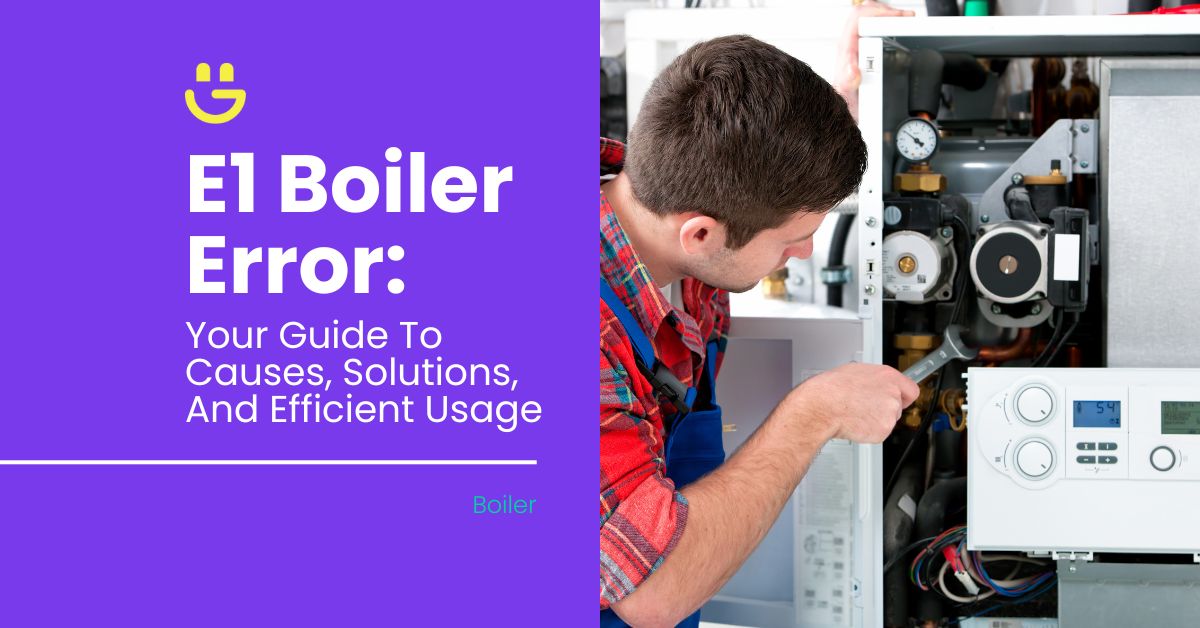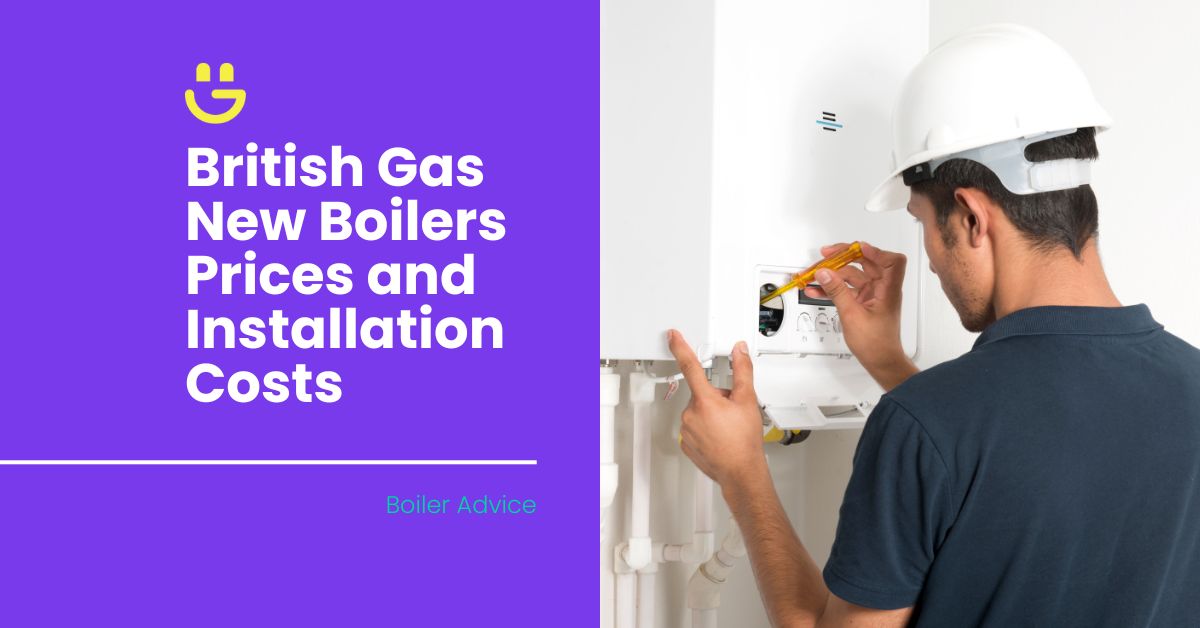Last Updated on November 14, 2025
If your boiler displays an E1 error code, don’t panic – it’s not the end of the world.
An E1 error generally means that your boiler pressure is too low, sometimes causing your boiler to lockout or stop working. This can be fixed by simply topping up the boiler pressure to between 1 and 2 bars.
However, there could be another issue or an underlying cause triggering the E1 error code. If you know the meaning of a specific E1 error code, you can diagnose and fix the problem quickly.
Promptly addressing an E1 error prevents damage to your water heater. It also ensures the device continues working, providing your home with warm water and central heating. Acting quickly also helps avoid costly repair bills.
Contents
Common Causes And Solutions Of The E1 Boiler Error
Most of the time, your water heater will display one of the following E1 error codes:
- E119: Low water pressure below 0.5 bars.
- E133: Ignition lockout due to a fault with the gas supply or ignition.
- E168: Your boiler detected a problem but has not identified the exact issue.
- E110: The water or flue system has overheated.
- E160, E50, E28, E20: A fault with a boiler component.
Let’s take a closer look at these error codes and how to fix them.
Low water pressure
- Error code: E119
- Solution: Repressurise the system by topping up the water.
When the heating appliance experiences low pressure (below 0.5 bar), it displays an E119 error code. While this isn’t necessarily a serious problem, it can affect the efficiency and functioning of your boiler. Low boiler pressure may also indicate potential leaks along the pipework or that your boiler is damaged (more on this shortly).
The easiest way to clear an E119 error code is to repressurise your boiler.
Here’s how to do it with an external filling loop:
- Turn off the boiler: Switch off your boiler and allow it to cool. This could take around 4-6 hours.
- Locate the filling loop: The filling loop is a bendable, silver pipe that has a valve on each end. Located beneath your unit, it should be fitted to your boiler’s pipes (if it is not, it might be causing a leak).
- Open the valves: Open both the valve connected to the boiler and the one connected to the pipework. This can be done by turning the tap handle anti-clockwise or by using a screwdriver.
- Listen for running water: Once the valves are open, you should hear running water flowing through the filling loop and into the boiler.
- Check the pressure gauge: The pressure should increase steadily. If not, there may be a fault with your pressure gauge. If your boiler has a hydraulic pressure gauge, the needle needs to move from the red section on the left to the green section in the middle.
- Close the valves: When the gauge reads that the pressure is at 1 bar, close both valves on the filling loop by turning the valves clockwise. Ensure that they are securely tightened (but not over-tightened).
- Switch on the boiler: When the pressure gauge has settled between 1 and 1.5 bars, turn the boiler back on via its switch.
If you have an internal filling key, repressurise your boiler using these steps:
- Find the internal filling key: Locate the small plastic tray on the side of the boiler and remove the internal filling key.
- Line up the arrow: Line up the key’s two white arrows (located near the bottom of the key) with the manifold (a black plastic part in your boiler that’s connected to your cold water mains).
- Identify the padlock icons: These symbols, placed next to each other, indicate how the internal filling key will be placed in the manifold.
- Place the key in the manifold: Insert the key inside the manifold, ensuring the white arrow is in line with the open padlock position.
- Turn the key: Turn the key clockwise until the two white arrows line up with the “closed” padlock position on the manifold.
- Turn the white nut: Once closed, turn the white plastic nut (located next to the key) counterclockwise. You should now hear water filling the boiler.
- Check the pressure gauge: Check the pressure gauge and wait for it to reach between 1 and 1.5 bars.
- Tighten the white nut: Once the pressure has reached 1-1.5 bars, tighten the white nut by turning it clockwise. You should hear the water stop flowing.
- Turn the internal filling: Turn the key back to the open padlock position, ensuring that the white arrow lines up with this symbol.
- Remove the key: Remove the key from the manifold. Note that a bit of water may drip out.
If your boiler is keyless with an internal filling loop, follow these steps to increase your boiler pressure:
- Locate the blue lever at the bottom of your boiler.
- Pull the lever and wait for the pressure to increase.
- Once you have reached a boiler pressure of more than 1.5 bar, let go of the lever.
If you notice that your boiler continues to lose pressure after you’ve topped it up and that the E1 error code reappears, you may have a leak along your central heating system or a faulty pressure relief valve.
Contact a Gas Safe engineer or a plumber to help resolve these issues.
Worried that your boiler pressure is too high after you’ve repressurised it? Read our helpful guide.
Gas supply issues
- Error code: E133
- Solution: Ensure there is a gas supply, reset the boiler, or contact a Gas Safe engineer.
When your boiler has a gas supply issue and detects an unsafe condition for the boiler, it displays an E133 error code and will shut down (lockout).
This indicates a possible ignition failure (pointing to an electrical supply problem), that the device’s flame is undetected, or that there is a frozen condensate pipe.
To fix an E133 error code:
- Check the gas supply: The easiest way to do this is by checking if other gas appliances in your home are functioning as usual. This indicates that there is a supply of gas coming into your home. If these appliances are working, check that the gas stopcock is open. If it is open but there is still no gas supply to your home and boiler, contact your gas supplier.
- Reset your boiler: Hold the reset button for five seconds to reset and reignite the system.
- Contact a Gas Safe registered engineer: If resetting your boiler does not clear the E133 error code, ensure the boiler is turned off and contact a Gas Safe engineer.
Remember, it is illegal to work on gas appliances (including boilers) or fittings if you are not a registered Gas Safe engineer. So, if your gas supply issues persist, you need to contact a Gas Safe engineer to help resolve your E133 error code.
Potential faults
If your appliance has detected a problem but has not identified the exact cause of the issue, it’ll display an E168 error code.
It may also display an E110, E160, E50, E28, E20, or E168 error code.
- To fix an E168 boiler error code: Note the code, shut down the boiler immediately, and contact a certified Gas Safe engineer.
- To fix an E110 error code: When a boiler shows an E110 fault, it shuts down because its water or flue system is overheated. Reset the appliance by rotating and holding the selector dial in its reset position for five seconds.
- To fix an E160, E50, E28, or E20 error code: Note the E1 fault code and contact your installer for assistance.
With these specific error codes, always contact your supplier or a Gas Safe registered engineer for advice.
Boiler-Specific E1 Error Codes
The E1 code on modern boilers often differs between brands.
Worcester Bosch
An E1 Worcester Bosch boiler fault code indicates a low-pressure issue. Check the pressure gauge and, if low, repressurise your boiler. If the problem persists, contact a Gas Safe engineer to service and repair the appliance.
Baxi
Common Baxi boiler fault codes are:
- E119: Indicates a drop in internal pressure to below 0.5 bar. Repressurise your boiler by topping up its water level.
- E133: This E1 error code indicates an issue with the gas feed to the appliance or a frozen condensate pipe. To fix this fault, follow the above directions to address the E133 error.
- E110: The boiler’s flue or primary water system overheated. To fix this issue, reset the appliance. Turn off the boiler if it fails to reset, and contact an installation professional.
- E168: The boiler picked up a problem but couldn’t identify the exact issue. Shut down the appliance and contact a Gas Safe registered engineer.
- E20, E28, E50, E160: These indicate a faulty component inside your boiler. Contact a Gas Safe registered engineer to install the correct replacement boiler part.
Ideal
An E1 error code on an Ideal boiler points to a low water level. Check the water level and fill the appliance to an acceptable level to help repressurise the device. If the E1 Ideal boiler fault code remains, consult a professional.
Potterton
Potterton boilers display the same fault codes as Baxi boilers. Check your specific error code and follow the instructions.
Main
A Main boiler also displays the same fault codes as Baxi boilers. To identify and fix the issue, check your specific error code and follow the relevant instructions.
Vaillant
Vaillant boiler fault codes do not include an E1 code. These fault codes are displayed as “F” errors instead. You must check your specific error code in your boiler manual to resolve the issue.
Signs Your Boiler Issue Goes Beyond DIY Fixes
These indicators let you know when to call in the help of a professional to fix your boiler issue:
- If the E1 error persists after basic troubleshooting (you have checked the gas feed and water level, and tried to repressurise your boiler).
- Your water heater experiences a sudden drop in water pressure or excessive gas consumption.
- The appliance vibrates or makes unusual noises.
- The boiler has visible leaks or damage to its components.
Regular maintenance and servicing can help prevent future E1 errors and ensure efficient boiler operation. Contact Eco Happy for assistance finding and replacing a broken part or component.
Tips For Efficient Boiler Usage
To ensure your heating system always performs at its best, follow these maintenance tips:
- Check the boiler’s pressure regularly and adjust water levels accordingly.
- Check that the gas feed is stable and look for possible leaks.
- Clean the appliance’s flue and vent regularly to prevent blockages.
- Schedule regular maintenance and servicing with a heating engineer.
FAQs
What is the normal operating pressure for a boiler?
A boiler operates best with an internal pressure between 1 and 2 bar. When switched on to provide heat and hot water, its pressure gauge may show a reading higher than 2 bar. A reading over 2.5 bar is too high. A boiler with low pressure shows a reading of less than 1 bar. The sweet spot you’re looking for is a pressure reading of 1.5 bar.
Can my home’s boiler operate without pressure?
No. A boiler with a pressure reading of between 1 and 0.5 bar will shut down automatically. Caused by faulty valves, failing radiator bleeder valves, or water leaks, low boiler pressure can reduce heating efficiency and damage your entire heating system and home.
A boiler that has not been used in a while will initially show a low-pressure reading but gradually build up pressure as its water heats up. However, a boiler with constant water pressure issues must be shut down and serviced by a professional.
Conclusion
Most boiler issues can be attended to and fixed if homeowners know what to look for. Therefore, many boiler manufacturers feature built-in display screens on their products, indicating the specific boiler error.
Displayed as E1 errors, these faults indicate common problems such as low water pressure and gas supply issues.
Knowing what each E1 error code means can help homeowners identify the problem, and promptly fix faulty gas boilers to prevent damage and high repair costs. Other E1 error codes require you to call a trained professional like Eco Happy to service and repair your heating appliance.
Regular maintenance also helps keep your boiler’s performance at its optimum and prevents future complications.






Tom Allen
Solar Expert